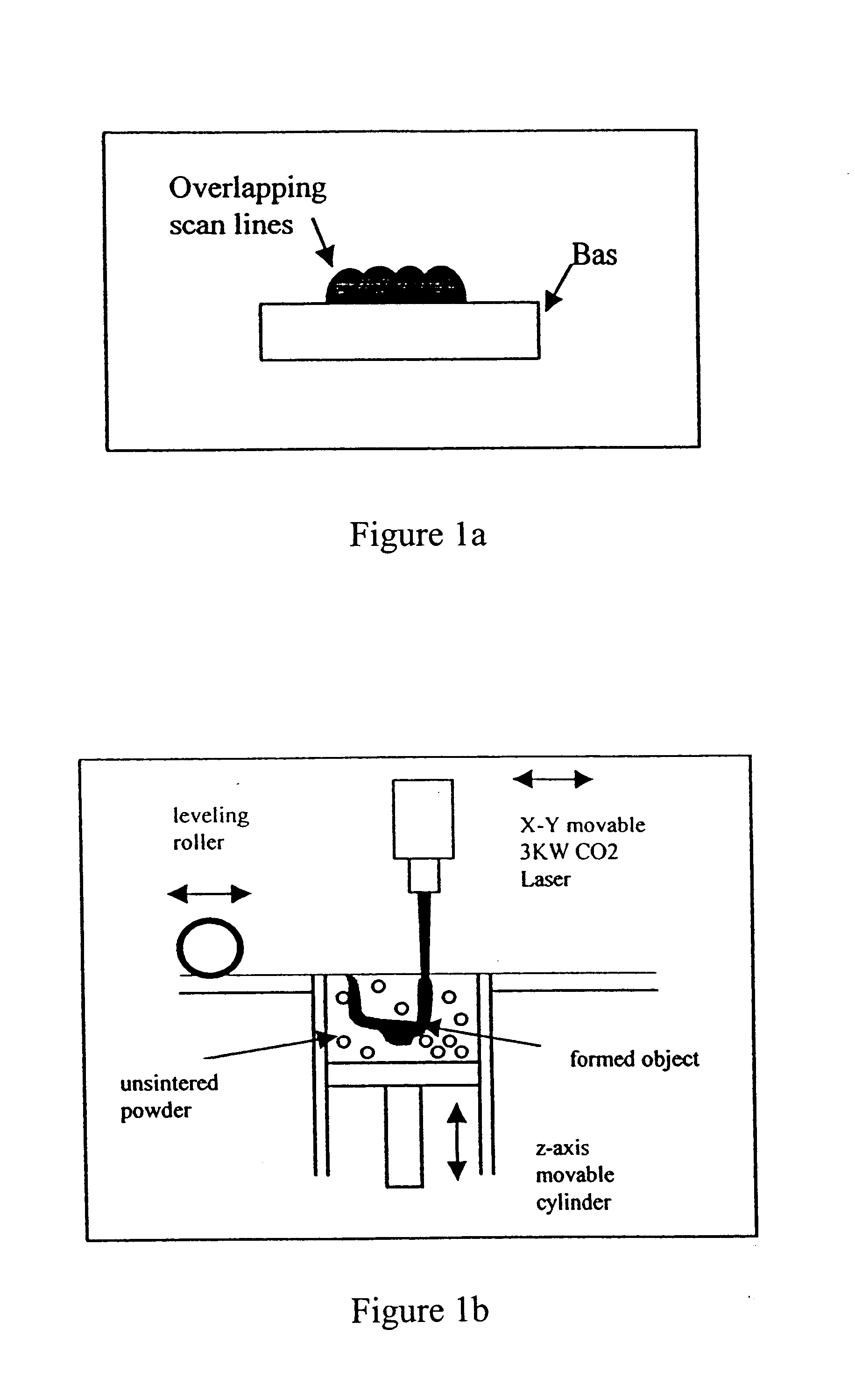Method of laser casting copper-based composites
a technology of laser casting and composites, applied in the direction of additive manufacturing, process efficiency improvement, additive manufacturing apparatus, etc., can solve the problems of reducing the effect of coating the powder surface to improve heat absorption or reduce reflection, and affecting the effect of thermal insulation
- Summary
- Abstract
- Description
- Claims
- Application Information
AI Technical Summary
Benefits of technology
Problems solved by technology
Method used
Image
Examples
example 1
Cu--Ni system
For the Cu and Ni powder system, the percentage of Ni was varied from 10% to 67% by weight. The powder mixture was first ball milled to form a powder mixture. After ball milling, laser casting was carried out. Formation of Cu--Ni solid solution was observed. Even at low percentages of Ni, the powder mixture could still be melted and formed into a dense part. The Cu--Ni powder system was therefore used as the matrix for Cu alloy based composites. FIGS. 2a and 2b show the X-ray diffraction (XRD) analysis results of the Cu--Ni powder system before and after the laser casting process. FIG. 2a shows the as-received Cu--Ni XRD spectrum where Cu and Ni diffraction peaks can be seen. After laser casting, pure Cu and Ni peaks disappeared and a new solid solution of Cu--Ni phase was detected. Microstructure of the laser cast Cu--Ni material is shown in FIG. 3a. Even at low percentage of Ni, a homogeneous phase has been formed without porosity. As can be seen in FIG. 3b, the laser...
example 2
Cu--WC (Ni) system
Cu was first ball milled with WC (with small amount of W.sub.2 C in the WC powder). Between 10% to 60% by weight of WC was used in the process. Structural analyses using X-ray diffraction before and after laser casting are shown in FIGS. 4a and 4b. X-ray diffraction spectra show no structural change after laser casting. Microstructure studies indicate porosity in the laser cast part when the powder mixture contains less than about 10% by weight of WC. FIG. 5a shows the microstructure of the laser cast Cu-6.7% WC composite. Porosity in the cast part can be seen in the figure. With increasing percentage of WC, porosity can be reduced. With the addition of Ni into the powder system (Cu--Ni matrix), the porosity was eliminated and a highly dense part of WC particles embedded in a solid solution of nickel in copper was formed. Ni addition can increase bonding between Cu and WC. The microphotograph in FIG. 5b shows that WC particles segregate at the boundaries of the cas...
example 3
Cu--Ti--C (Ni) system
Laser casting of Cu--Ti--C (Ni) should be well protected to avoid oxidation of Ti powder since it is very reactive. Besides the use of an Argon chamber, direct purging with Argon gas is also possible. In-situ formation of TiC was observed in Cu--Ti--C systems as shown in FIG. 6. The formation of in-situ TiC can be observed from the TiC diffraction peaks, as shown in FIG. 6b. After the laser scan, Ti and C reacted completely with each other and no Ti was detected from the XRD results. Microstructure analysis showed that TiC was well distributed in the matrix. However, the part formed after laser casting was found to be relatively porous. At high percentages of Ti and C (calculated resultant 50% TiC) in the powder mixture of Cu--Ti--C, the powder did not fuse together after the laser sintering process. With the addition of Ni (at about 10%), the powder fused together to form a part with low porosity. FIG. 7 shows the dense microstructure of the Cu--Ti--C--Ni syste...
PUM
| Property | Measurement | Unit |
|---|---|---|
| diameter | aaaaa | aaaaa |
| weight ratio | aaaaa | aaaaa |
| wavelength | aaaaa | aaaaa |
Abstract
Description
Claims
Application Information
 Login to View More
Login to View More - R&D
- Intellectual Property
- Life Sciences
- Materials
- Tech Scout
- Unparalleled Data Quality
- Higher Quality Content
- 60% Fewer Hallucinations
Browse by: Latest US Patents, China's latest patents, Technical Efficacy Thesaurus, Application Domain, Technology Topic, Popular Technical Reports.
© 2025 PatSnap. All rights reserved.Legal|Privacy policy|Modern Slavery Act Transparency Statement|Sitemap|About US| Contact US: help@patsnap.com



